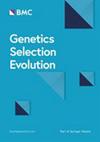全基因组重测序揭示了与中国本土猪早熟性状相关的正选择和渐渗特征和遗传位点
IF 3.1
1区 农林科学
Q1 AGRICULTURE, DAIRY & ANIMAL SCIENCE
引用次数: 0
摘要
猪表型多样性的遗传基础受整个基因组变异的调控,尤其是早熟性状,这是提高猪的繁殖能力和养猪业经济效益的关键性状。然而,猪的早熟性状的遗传基础在很大程度上仍然未知。在这里,我们报告了基于59个不同猪品种或群体的493份材料的重测序的猪的全面基因组变异图,其中包括5,211,469个单核苷酸多态性(snp)和487,725个小插入/删除结构变异(InDels)。该集合包括45,640个高质量结构变体(SVs)。结果表明,在遗传水平上,汉江黑猪与江海型猪属于一类,部分个体的基因组特征具有一定程度的欧洲猪特征。通过基因渗入和特征选择分析,我们确定了几个与骨骼发育和青春期早期特征相关的候选基因,如TBX5、PAPPA2、IGFBP3和MKRN3。此外,GWAS和差异表达分析结果表明,PAPPA2基因与猪的性早熟有关。研究表明,过去的遗传渗入事件会影响猪的农艺性状,并为猪的遗传育种提供原料。此外,我们的研究结果表明,PAPPA2基因是与猪性成熟早相关的候选基因,其基因组分析对研究猪的经济性状具有重要的参考价值。本文章由计算机程序翻译,如有差异,请以英文原文为准。
Whole-genome resequencing reveals positive selection and introgression signatures and genetic loci associated with early puberty traits in Chinese indigenous pigs
The genetic basis of the phenotypic diversity of pigs is regulated by variants across the genome, especially the trait of early puberty, which is a crucial trait for enhancing the reproductive ability of pigs and the economy of the pig industry. However, the genetic basis of the early puberty trait in pigs remains largely unknown. Here, we report a comprehensive genomic variation map for pigs based on the resequencing of 493 accessions representing 59 different pig breeds or populations, which included 5,211,469 single-nucleotide polymorphisms (SNPs) and 487,725 small insertion/deletion structure variants (InDels). This sets included 45,640 high-quality structural variants (SVs). Our results suggested that Hanjiang black (HJB) pigs cluster with Jianghai-type pigs at the genetic level and that the genome characteristics of some HJB individuals exhibit a certain degree of European pig features. Using introgression and signature selection analysis, we identified several candidate genes associated with bone development and early puberty traits, such as TBX5, PAPPA2, IGFBP3, and MKRN3. Additionally, the GWAS and differential expression analysis results suggested that the PAPPA2 gene is associated with early puberty in pigs. This study revealed that past introgression events could impact the agronomical traits of pigs and contribute raw material of genetics and breeding in pig. Moreover, our results suggest that the PAPPA2 gene is a candidate gene associated with early sexual maturity in pigs and the genomic analysis provided important reference value for studying economic traits for pigs.
求助全文
通过发布文献求助,成功后即可免费获取论文全文。
去求助
来源期刊

Genetics Selection Evolution
生物-奶制品与动物科学
CiteScore
6.50
自引率
9.80%
发文量
74
审稿时长
1 months
期刊介绍:
Genetics Selection Evolution invites basic, applied and methodological content that will aid the current understanding and the utilization of genetic variability in domestic animal species. Although the focus is on domestic animal species, research on other species is invited if it contributes to the understanding of the use of genetic variability in domestic animals. Genetics Selection Evolution publishes results from all levels of study, from the gene to the quantitative trait, from the individual to the population, the breed or the species. Contributions concerning both the biological approach, from molecular genetics to quantitative genetics, as well as the mathematical approach, from population genetics to statistics, are welcome. Specific areas of interest include but are not limited to: gene and QTL identification, mapping and characterization, analysis of new phenotypes, high-throughput SNP data analysis, functional genomics, cytogenetics, genetic diversity of populations and breeds, genetic evaluation, applied and experimental selection, genomic selection, selection efficiency, and statistical methodology for the genetic analysis of phenotypes with quantitative and mixed inheritance.
 求助内容:
求助内容: 应助结果提醒方式:
应助结果提醒方式:


